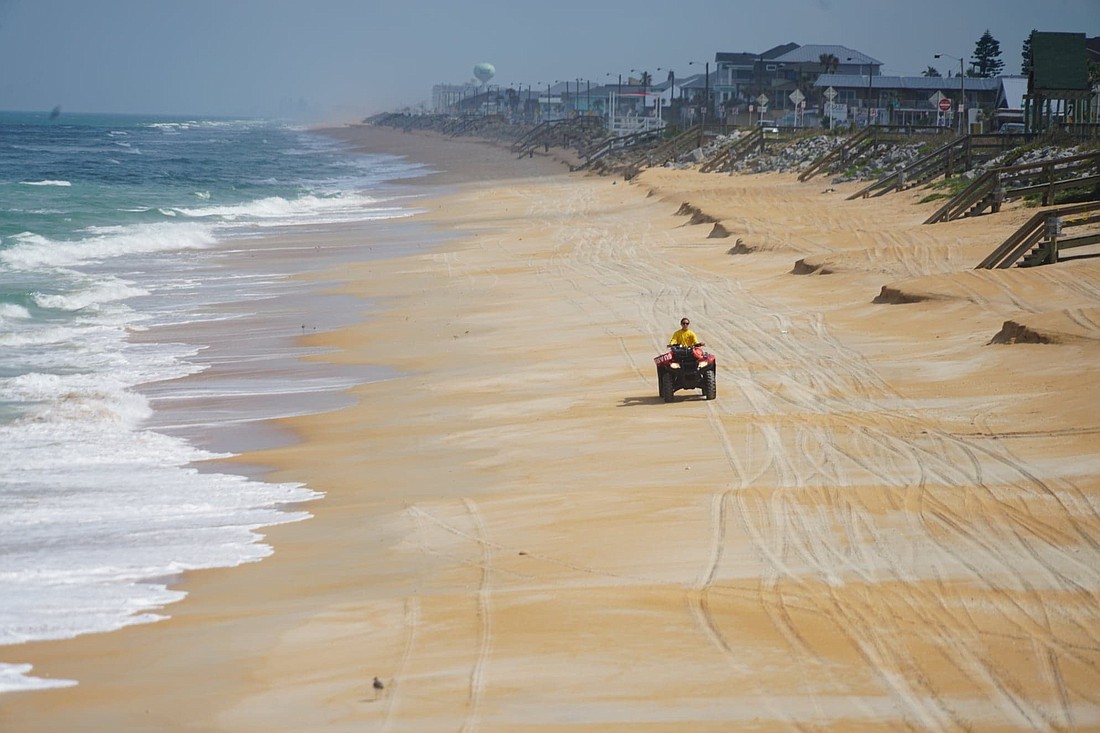- December 15, 2025

The Army Corps of Engineers beach renourishment project along a 2.6-mile stretch of Flagler Beach may begin next June, and will require at least twice as much sand as previously anticipated.
"I'm excited to see it finally getting close to the finish line," Jason Harrah, a senior project manager with the Army Corps of Engineers, told Flagler Beach city commissioners at an Aug. 18 commission meeting. "I'm eagerly holding my breath and we'll get there, but I think we're definitely closer than we have been in years past."
The county government is still working to secure the final easements required for the project to proceed, County Attorney Al Hadeed said at the meeting.
"We are proceeding to take all the steps we need to take in conjunction with all of our partners to procure those easements," he said.
The Army Corps of Engineers requires access easements from all property owners in the project area so that workers can enter privately owned beachfront property east of A1A to add sand. The federal government won't start the project unless it has access easements for each of the 141 properties in the project area, because if workers skip the renourishment effort for one property because they can't enter it, that creates a breach point where seawater would rush through the dune during a storm, undermining the entire thing.
In the Flagler County project area, the land east of A1A is vacant and nothing can be built on it aside from dune walkovers. But the parcels east of A1A are linked to ones bearing homes and businesses west of A1A, and a number of property owners have resisted granting easements.
Some relented after a community group paid them to sign easements, and the county government has managed to convince all but one of the holdouts — Cynthia D’Angiolini, who has two properties in the project area — to sign, and has warned that it will use eminent domain to gain access if she refuses.
If the county can't secure all easements by the Corps of Engineers' Dec. 30 deadline, the federal government will likely reallocate the money elsewhere and there will be no Army Corps project — leaving the homes and businesses in what would have been the project area more susceptible to flooding, and A1A more at risk of erosion damage.
Harrah said that plenty of other communities are ready to take that federal funding if Flagler doesn't make the deadline.
"Folks up the line through Washington D.C. are patiently waiting to see if 30 December happens," he said. "There are a lot of coastal programs and projects from here through Boston that ... have plans and specs done, that are waiting for this money that would love to have it. So we have been fighting that off."
He gave an overview of the project's history. The Army Corps had first started a shoreline study of Flagler County in 2002. It finished it in 2014, ultimately selecting a 2.6-mile project area that would stretch from South Sixth Street to South 28th Street.
The Corps of Engineers planned to use 330,000 cubic yards of sand for the project.
In 2016, Hurricane Matthew hit. The Corps secured funding for the project in 2018, and, in 2019, adjusted its plans to allow for more sand: a total of 595,000 cubic yards.
In March 2020, the Army Corps of Engineers was ready to move forward, but the county government was still struggling to get beachfront property owners to sign easements that would let the workers access their land.
In the meantime, nor'easters removed more sand from the beach, and new Army Corps surveys showed that the project would require 772,000 cubic yards of sand.
If erosion proceeds apace, the project may take 1.2 million cubic yards of sand, Harrah said.
The Corps of Engineers has about 20 beach projects around the state, he noted.
"Miami, Tampa, Martin County, Nassau County — the majority of the beaches that you put a chair in are man-made," he said. "Some of those beaches are remade every five to seven years. You get down to Miami, they're done every year."
If the federal project moves forward, the Army Corps of Engineers would renourish the beach regularly over the project's 50-year lifespan, and would also renourish as needed after major storms, a the federal government's expense.
"Anytime we have a significant storm that has a presidential declaration, we come in at 100% federal [funding] and replace that beach," Harrah said. "The county is not on the hook for anything."